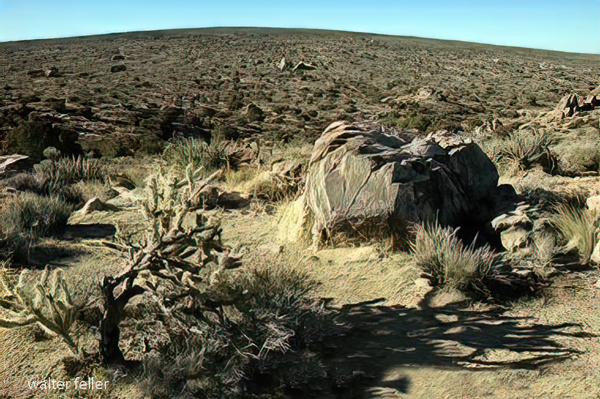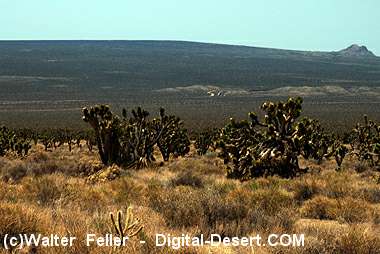--
Cima Dome

Cima Dome from Teutonia Peak Trail - January 2008
Cima Dome is famous for its remarkably smooth dome shape. At one time, Cima Dome was a rugged, craggy mountain. How did it
become so rounded? The story starts with the granite it’s made from.
Mojave’s granitic rocks started out as great masses of molten rock called magma, deep beneath the Earth’s surface. Vast
expanses of solid minerals and simmering magma once fed explosive volcanoes miles above. Not all of the magma erupted at the surface. Much of the fiery mass remained trapped deep below miles of rock, allowing it to cool and solidify very slowly. With plenty of time to grow, large crystals formed, giving granitic rocks their distinctive coarse, grainy texture.
Most granitic rock in the Mojave Desert is old! Igneous rocks, rocks that crystallize from molten rock, date their birth the moment they solidify. Mojave’s granites solidified during the Mesozoic Era, from 80 to 180 million years ago.
Many millions of years later, tectonic forces lifted these deep rocks to the surface, forming a high mountain range. Once exposed at the Earth’s surface, other forces, weathering and erosion, began the work of breaking the mountains down.
Nibbling away the mountain
Once at the surface, granite falls victim to the slow, gnawing forces ofweathering and erosion. Water falling on the rock as rain or snow and groundwater percolating just beneath the surface begins to disintegrate the rock grain by grain.
Water and dust particles gradually work their way between individual mineral grains. Mica and feldspar grains in the granitic rock chemically react with the water and decompose to form clay minerals. Clay minerals and dust tend to swell-up when they get wet, then shrink when they dry out. These tiny particles act as wedges between more chemically resistant minerals, prying them loose from the solid rock, like the potassium feldspar grains in the image on the right. Over time, the granite ‘rots’ and streams begin to carry away the loose, rotten granitic soil.
Eventually, the mountain retreats back, leaving a gently sloping surface behind. Over millions of years mountains can retreat so that just a few exposed boulders remain, like those you see on the top of Cima Dome.
Also see:
Geology:
Land Formation & Erosional Processes
Playa/Dry Lake Formation
Mojave Preserve Geology
Related pages:
Pediments and Alluvial Fans - Mojave Desert
Perhaps the most notable pediment in the region is Cima Dome, a very broad, ... The broad, gradual arch of Cima Dome is a mature pediment surface broken by ...Sensitive Habitats
The most obvious feature of Cima Dome, next to its unique geological form, is the Joshua tree (Yucca brevifolia jaegeriana). The Joshua tree woodland covering ...Geology of Mojave Preserve
Famous for its remarkably smooth dome shape. At one time, Cima Dome was a rugged, craggy mountain. How did it become so rounded? The story starts with ...Flora - Mojave Desert
The Preserve is unusual in the complexity and density of the Joshua tree community, which is represented on Cima Dome. The quality and sheer vastness of the ...Mojave Desert Points of Interest
Cima Dome · Cima Ghost Town · Cinder Cones · Colorado Desert · Colorado Desert (Joshua Tree NP) - - Colorado River - - Colorado River (Route 66) - - ...Flora & Fauna of the Mojave Preserve
source - NPS, Common fauna (jackrabbit) takes a break from the midsummer heat. Joshua tree woodland on Cima Dome ...References - Mojave Preserve - California Mojave Desert
Sharp, R.P., 1954, The nature of Cima Dome: In Jahns, R.H. (ed.), Geology of southern California, [Part 8], v. 68, no. 3, p. 49-52. Sharp, R.P., 1982, Kelso Dunes: ...Desert Tortoise - Mojave Desert
The northern area includes Ivanpah Valley, south of Nipton Road, including the areas north, west and south of Cima Dome, extending up to Interstate 15.Volcanic Rocks, Cinder Cones and Lava Fields
Cinder Cones National Natural Landmark. The skyline of Cima Dome is interrupted by the conical outlines of dozens of remarkably well-preserved .Mojave Preserve Map
Kelso Dunes · Mitchell Caverns · Hole in the Wall · Nipton, Ca. Ludlow, Ca. Cima Dome · Kelso Depot · Soda Lake · Mojave Road · Cima Ghost Town ...Joshua Tree Woodland - Desert Habitats
The world's largest concentration of Joshua trees grows on Cima Dome in the Mojave National Preserve. Compare them with other yuccas that typically grow ...Cinder Cones
The skyline of Cima Dome is interrupted by the conical outlines of dozens of remarkably well-preserved volcanic cinder cones and black basalt lava flows.Ranching History in the Mojave Desert
... the Joshua tree forests of Cima Dome and Lanfair Valley. Biologist Harold Avery noted that cattle grazing in the Mojave had the effect of increasing the number ...
Cima Dome from the Mojave Road (Teutonia Peak on right)

Teutonia Peak at sunrise
Mojave Geomorphic Province
Mojave Desert Ecosection